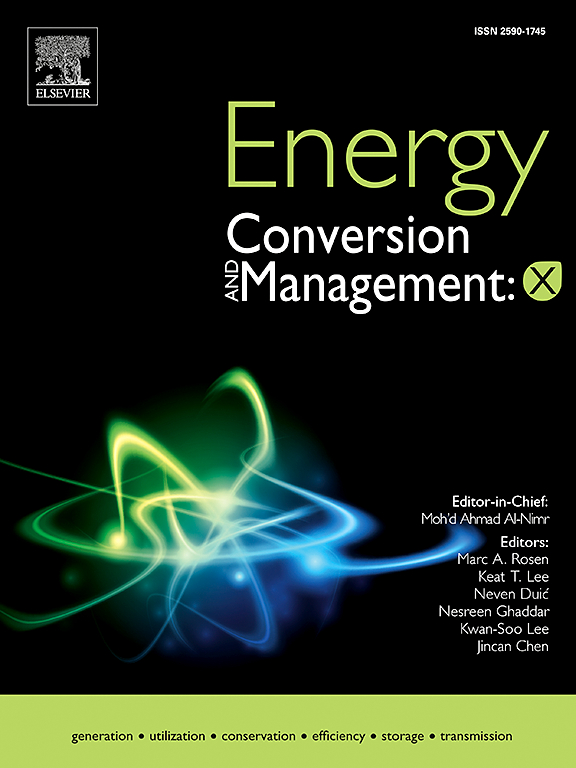Future scenarios for 100% renewables in Greece, untapped potential of marine renewable energies
IF 7.1
Q1 ENERGY & FUELS
引用次数: 0
Abstract
This study examines the potential contribution of marine renewable generators in Greece, in order to achieve a 100% renewable energy system by 2050. Using PyPSA-Eur, a cost-optimization model of the European energy system, possible energy transition pathways are explored, across five-year intervals from 2030 to 2050. For each five-year target, a new cost assumption dataset is used, one that follows estimated cost reduction learning rates. This version of the model is called PyPSA-Eur-MREL, and is modified to include marine power generators, i.e. floating wind, wave, tidal and floating solar, but also high fidelity climate data, in the scale of 5.5 for wind and 4 for wave resources. Three different approaches were employed in this investigation: greenfield, generator constrained, and a high-load scenario inspired by Greece’s National Energy and Climate Plan (NECP). The analysis focused on generator capacity and performance, the levels of utilization and availability of each energy carrier and the land-use impact of onshore and offshore generators. While the first two scenarios exhibit similar overall system capacities, they differ in land-use requirements, with the constrained case installing more bottom-fixed wind turbines (1.2 GW), thereby reducing land occupation. The high-load scenario introduces floating wind turbines (4.5 GW), however, the scale of onshore installations remains substantial, covering nearly one-third of Greece’s total land area.
希腊100%可再生能源的未来情景,海洋可再生能源的潜力尚未开发
本研究考察了希腊海洋可再生能源发电机的潜在贡献,以便到2050年实现100%的可再生能源系统。利用欧洲能源系统的成本优化模型PyPSA-Eur,探索了从2030年到2050年的五年间隔内可能的能源转型途径。对于每个五年目标,使用一个新的成本假设数据集,该数据集遵循估计的成本降低学习率。这个版本的模型被称为PyPSA-Eur-MREL,经过修改,包括海洋发电机,即漂浮风、波浪、潮汐和漂浮太阳能,以及高保真的气候数据,风的尺度为5.5平方公里,波浪资源的尺度为4平方公里。本次调查采用了三种不同的方法:绿地、发电机约束和受希腊国家能源和气候计划(NECP)启发的高负荷情景。分析的重点是发电机的容量和性能、每种能源载体的利用水平和可用性以及陆上和海上发电机对土地使用的影响。虽然前两种方案显示出类似的总体系统容量,但它们在土地使用要求上有所不同,在受限的情况下安装了更多的底部固定风力涡轮机(1.2吉瓦),从而减少了土地占用。高负荷情景引入了浮动风力涡轮机(4.5吉瓦),然而,陆上装置的规模仍然很大,覆盖了希腊总陆地面积的近三分之一。
本文章由计算机程序翻译,如有差异,请以英文原文为准。
求助全文
约1分钟内获得全文
求助全文
来源期刊

Energy Conversion and Management-X
Multiple-
CiteScore
8.80
自引率
3.20%
发文量
180
审稿时长
58 days
期刊介绍:
Energy Conversion and Management: X is the open access extension of the reputable journal Energy Conversion and Management, serving as a platform for interdisciplinary research on a wide array of critical energy subjects. The journal is dedicated to publishing original contributions and in-depth technical review articles that present groundbreaking research on topics spanning energy generation, utilization, conversion, storage, transmission, conservation, management, and sustainability.
The scope of Energy Conversion and Management: X encompasses various forms of energy, including mechanical, thermal, nuclear, chemical, electromagnetic, magnetic, and electric energy. It addresses all known energy resources, highlighting both conventional sources like fossil fuels and nuclear power, as well as renewable resources such as solar, biomass, hydro, wind, geothermal, and ocean energy.
 求助内容:
求助内容: 应助结果提醒方式:
应助结果提醒方式:


